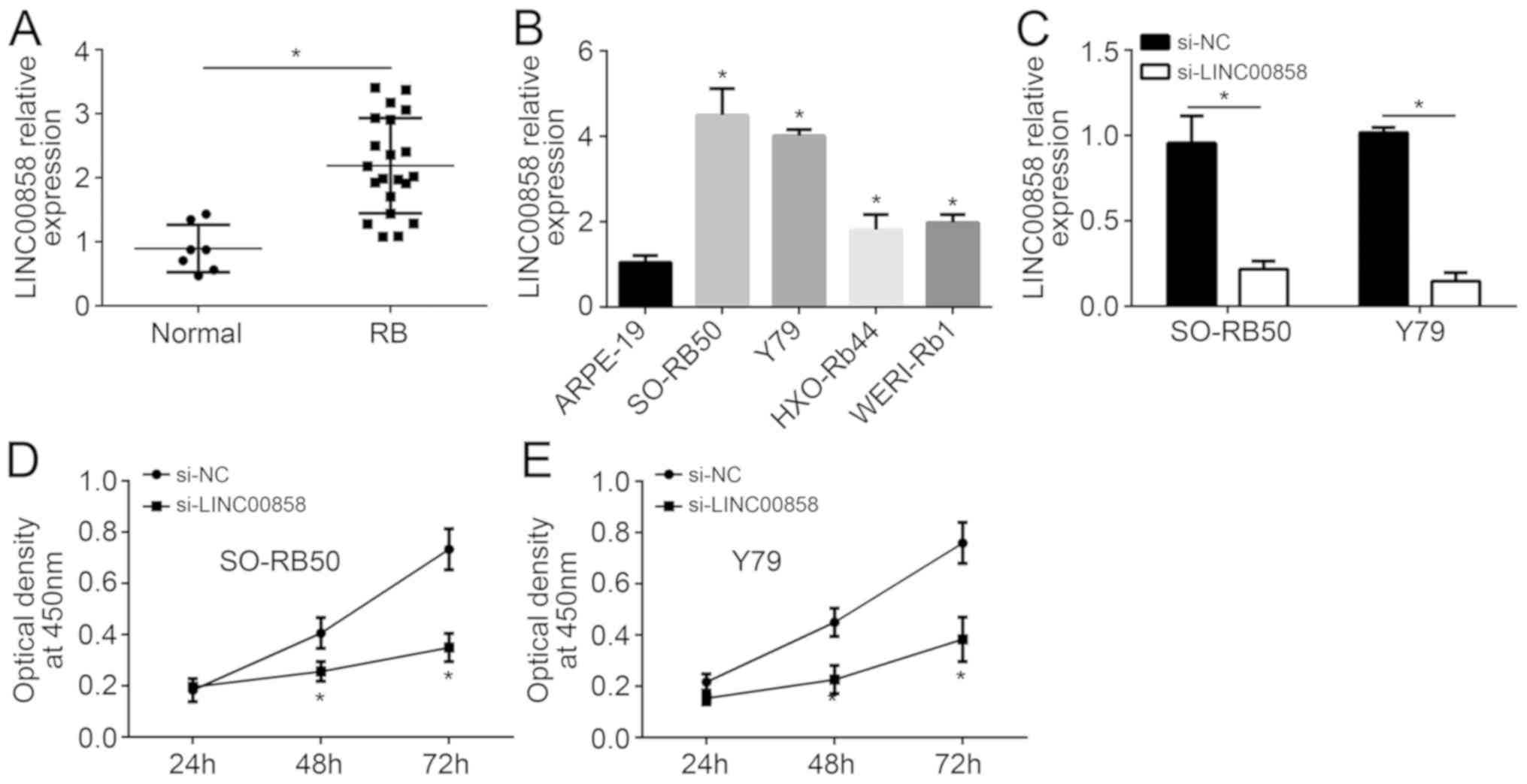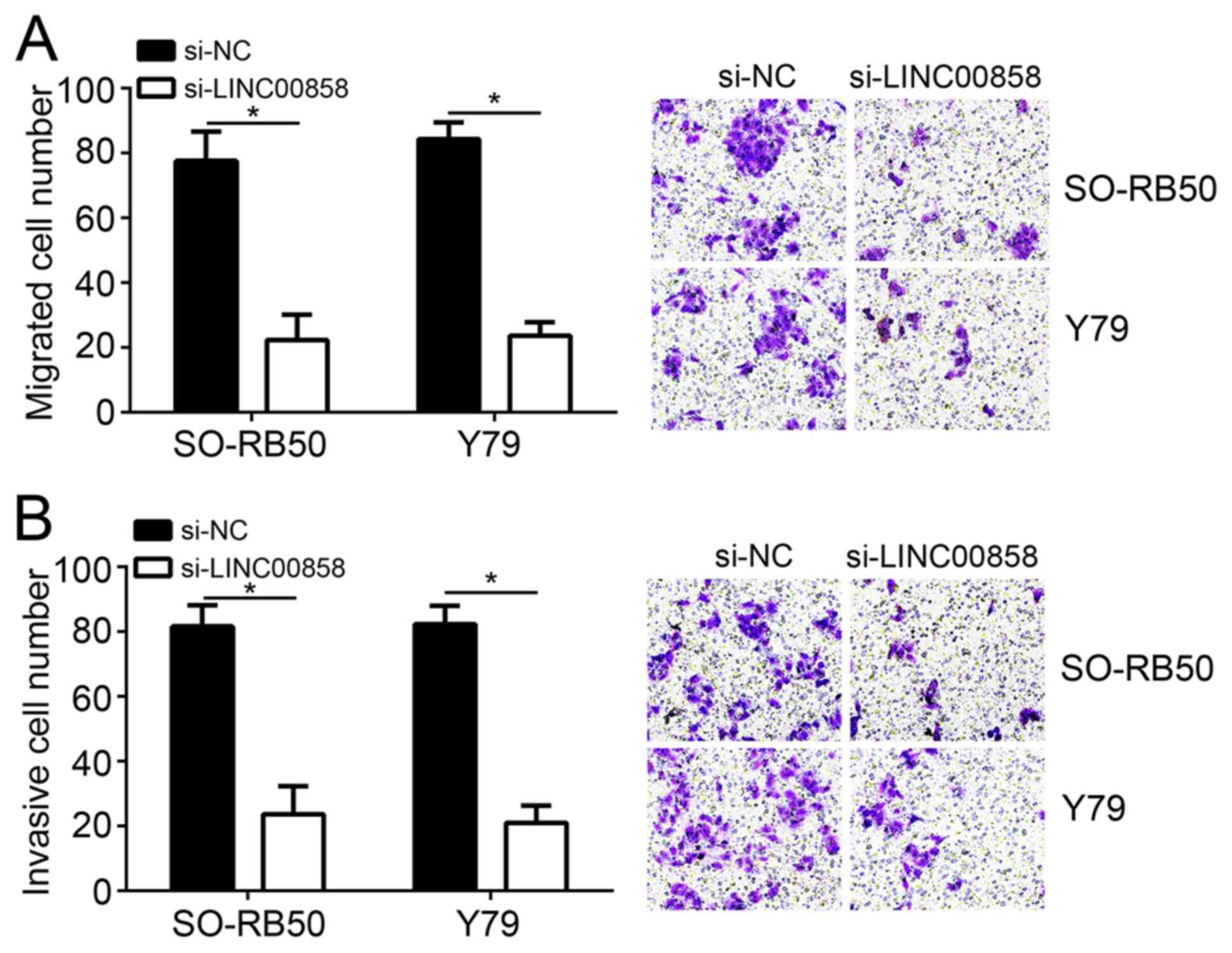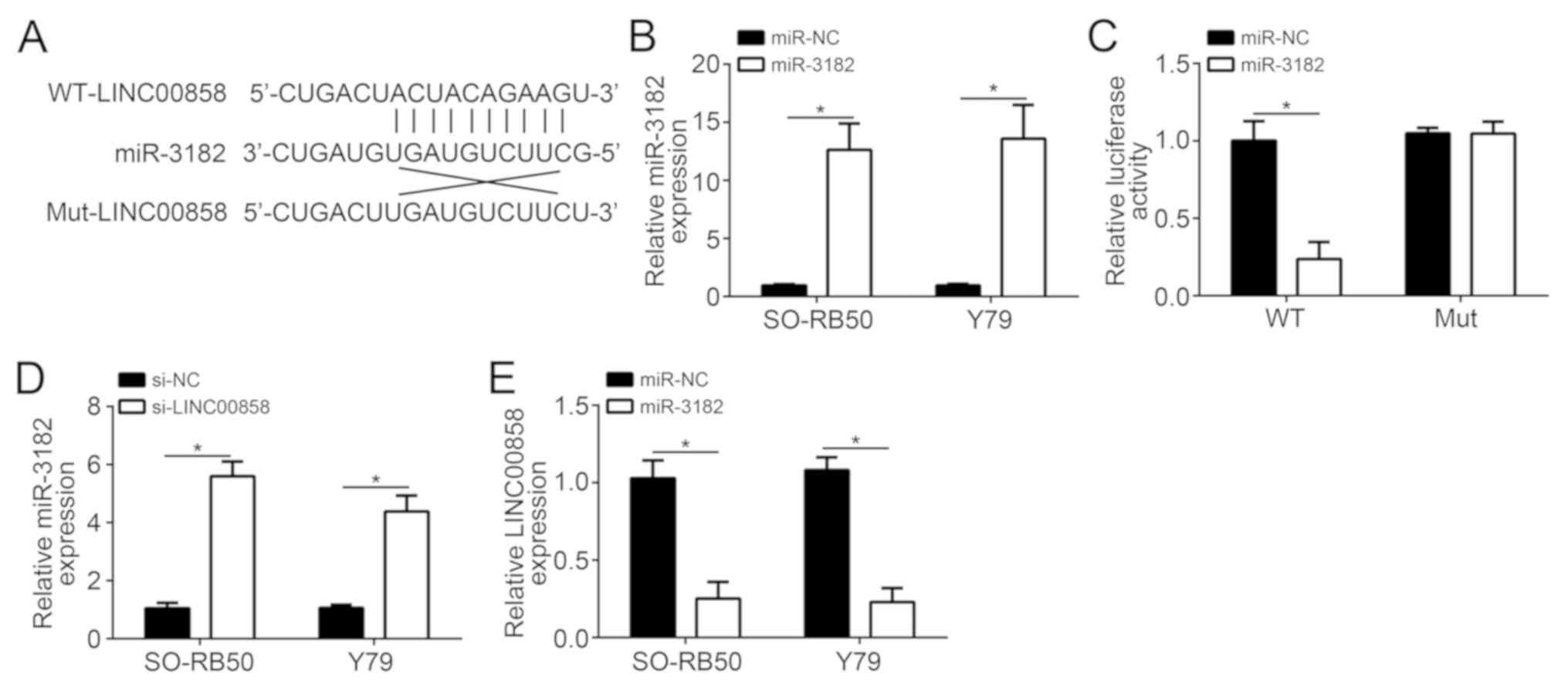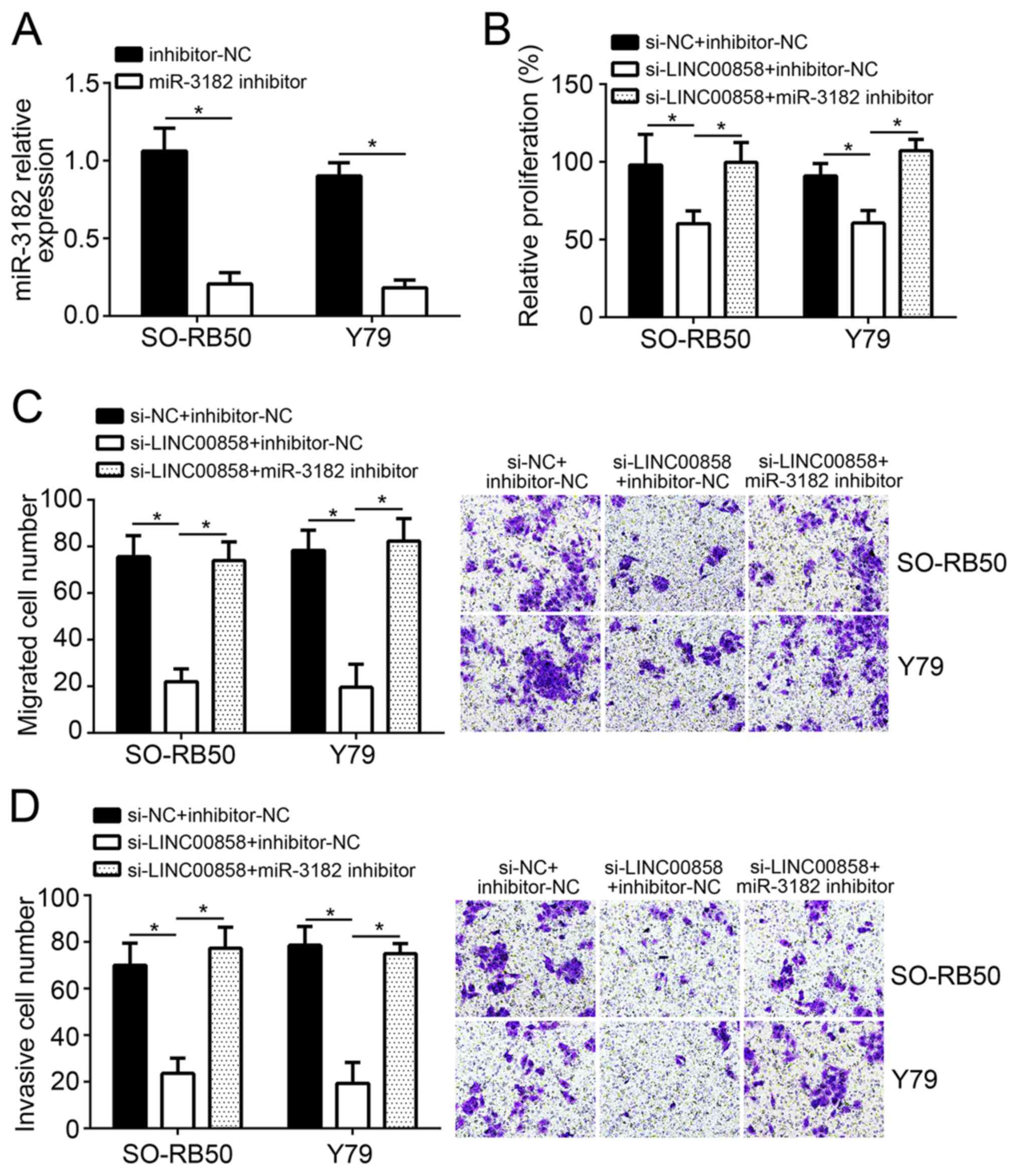|
1
|
Broaddus E, Topham A and Singh AD:
Incidence of retinoblastoma in the USA: 1975–2004. Br J Ophthalmol.
93:21–23. 2009. View Article : Google Scholar : PubMed/NCBI
|
|
2
|
Dimaras H, Corson TW, Cobrinik D, White A,
Zhao J, Munier FL, Abramson DH, Shields CL, Chantada GL, Njuguna F
and Gallie BL: Retinoblastoma. Nat Rev Dis Primers. 1:150212015.
View Article : Google Scholar : PubMed/NCBI
|
|
3
|
Dolcino M, Pelosi A, Fiore PF, Patuzzo G,
Tinazzi E, Lunardi C and Puccetti A: Long non-coding RNAs play a
role in the pathogenesis of psoriatic arthritis by regulating
MicroRNAs and genes involved in inflammation and metabolic
syndrome. Front Immunol. 9:15332018. View Article : Google Scholar : PubMed/NCBI
|
|
4
|
Mathy NW and Chen XM: Long non-coding RNAs
(lncRNAs) and their transcriptional control of inflammatory
responses. J Biol Chem. 292:12375–12382. 2017. View Article : Google Scholar : PubMed/NCBI
|
|
5
|
Kapinova A, Kubatka P, Zubor P,
Golubnitschaja O, Dankova Z, Uramova S, Pilchova I, Caprnda M,
Opatrilova R, Richnavsky J, et al: The hypoxia-responsive long
non-coding RNAs may impact on the tumor biology and subsequent
management of breast cancer. Biomed Pharmacother. 99:51–58. 2018.
View Article : Google Scholar : PubMed/NCBI
|
|
6
|
Zhang A, Shang W, Nie Q, Li T and Li S:
Long non-coding RNA H19 suppresses retinoblastoma progression via
counteracting miR-17-92 cluster. J Cell Biochem. 119:3497–3509.
2018. View Article : Google Scholar : PubMed/NCBI
|
|
7
|
Xue M, Shi D, Xu G and Wang W: The long
noncoding RNA linc00858 promotes progress of lung cancer through
miR-3182/MMP2 axis. Artif Cells Nanomed Biotechnol. 47:2091–2097.
2019. View Article : Google Scholar : PubMed/NCBI
|
|
8
|
Sha QK, Chen L, Xi JZ and Song H: Long
non-coding RNA LINC00858 promotes cells proliferation, migration
and invasion by acting as a ceRNA of miR-22-3p in colorectal
cancer. Artif Cells Nanomed Biotechnol. 47:1057–1066. 2019.
View Article : Google Scholar : PubMed/NCBI
|
|
9
|
Gu Z, Hou Z, Zheng L, Wang X, Wu L and
Zhang C: Long noncoding RNA LINC00858 promotes osteosarcoma through
regulating miR-139-CDK14 axis. Biochem Biophys Res Commun.
503:1134–1140. 2018. View Article : Google Scholar : PubMed/NCBI
|
|
10
|
Zhong W, Yang J, Li M, Li L and Li A: Long
noncoding RNA NEAT1 promotes the growth of human retinoblastoma
cells via regulation of miR-204/CXCR4 axis. J Cell Physiol.
234:11567–11576. 2019. View Article : Google Scholar : PubMed/NCBI
|
|
11
|
Wu XZ, Cui HP, Lv HJ and Feng L: Knockdown
of lncRNA PVT1 inhibits retinoblastoma progression by sponging
miR-488-3p. Biomed Pharmacother. 112:1086272019. View Article : Google Scholar : PubMed/NCBI
|
|
12
|
Meng B, Wang Y and Li B: Suppression of
PAX6 promotes cell proliferation and inhibits apoptosis in human
retinoblastoma cells. Int J Mol Med. 34:399–408. 2014. View Article : Google Scholar : PubMed/NCBI
|
|
13
|
Livak KJ and Schmittgen TD: Analysis of
relative gene expression data using real-time quantitative PCR and
the 2(-Delta Delta C(T)) method. Methods. 25:402–408. 2001.
View Article : Google Scholar : PubMed/NCBI
|
|
14
|
Lei R, Xue M, Zhang L and Lin Z: Long
noncoding RNA MALAT1-regulated microRNA 506 modulates ovarian
cancer growth by targeting iASPP. Onco Targets Ther. 10:35–46.
2016. View Article : Google Scholar : PubMed/NCBI
|
|
15
|
Liu W, Ma R and Yuan Y:
Post-transcriptional regulation of genes related to biological
behaviors of gastric cancer by long noncoding RNAs and MicroRNAs. J
Cancer. 8:4141–4154. 2017. View Article : Google Scholar : PubMed/NCBI
|
|
16
|
Ponting CP, Oliver PL and Reik W:
Evolution and functions of long noncoding RNAs. Cell. 136:629–641.
2009. View Article : Google Scholar : PubMed/NCBI
|
|
17
|
Mercer TR, Dinger ME and Mattick JS: Long
non-coding RNAs: Insights into functions. Nat Rev Genet.
10:155–159. 2009. View
Article : Google Scholar : PubMed/NCBI
|
|
18
|
Wilusz JE, Sunwoo H and Spector DL: Long
noncoding RNAs: Functional surprises from the RNA world. Genes Dev.
23:1494–1504. 2009. View Article : Google Scholar : PubMed/NCBI
|
|
19
|
Qiao L, Liu X, Tang Y, Zhao Z, Zhang J and
Feng Y: Down regulation of the long non-coding RNA PCAT-1 induced
growth arrest and apoptosis of colorectal cancer cells. Life Sci.
188:37–44. 2017. View Article : Google Scholar : PubMed/NCBI
|
|
20
|
Li A, Yan Q, Zhao X, Zhong J, Yang H, Feng
Z, Du Y, Wang Y, Wang Z, Wang H, et al: Decreased expression of
PBLD correlates with poor prognosis and functions as a tumor
suppressor in human hepatocellular carcinoma. Oncotarget.
7:524–537. 2016.PubMed/NCBI
|
|
21
|
Zhu SP, Wang JY, Wang XG and Zhao JP: Long
intergenic non-protein coding RNA 00858 functions as a competing
endogenous RNA for miR-422a to facilitate the cell growth in
non-small cell lung cancer. Aging (Albany NY). 9:475–486. 2017.
View Article : Google Scholar : PubMed/NCBI
|
|
22
|
Xu G, Chen J, Pan Q, Huang K, Pan J, Zhang
W, Chen J, Yu F, Zhou T and Wang Y: Long noncoding RNA expression
profiles of lung adenocarcinoma ascertained by microarray analysis.
PLoS One. 9:e1040442014. View Article : Google Scholar : PubMed/NCBI
|
|
23
|
Li T, Meng XL and Yang WQ: Long noncoding
RNA PVT1 acts as a ‘Sponge’ to inhibit microRNA-152 in gastric
cancer cells. Dig Dis Sc. 62:3021–3028. 2017. View Article : Google Scholar
|
|
24
|
Razaviyan J, Hadavi R, Tavakoli R, Kamani
F, Paknejad M and Mohammadi-Yeganeh S: Expression of miRNAs
targeting mTOR and S6K1 genes of mTOR signaling pathway including
miR-96, miR-557, and miR-3182 in triple-negative breast cancer.
Appl Biochem Biotechnol. 186:1074–1089. 2018. View Article : Google Scholar : PubMed/NCBI
|
|
25
|
Zhu KP, Ma XL and Zhang CL: LncRNA ODRUL
contributes to osteosarcoma progression through the miR-3182/MMP2
axis. Mol Ther. 25:2383–2393. 2017. View Article : Google Scholar : PubMed/NCBI
|



















